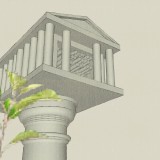
Image: Wikipedia (our picture of the NHM’s coyote brush hedge came out blurry–which really is a shame because they were good looking hedges. You wouldn’t guess it from this pic).
One of a series of posts inspired by our recent tour of the new gardens at the Los Angeles Natural History Museum.
Baccharis pilularis, called coyote brush, or chaparral bloom, is an unassuming Western native plant with a secret super-power: native and non-native pollinators love, love, love! its tiny little flowers. If you want to lavish affection and care on the pollinators in your garden, plant one of these babies, if you can. It really is one of the best plants for the purpose. (For more info on coyote brush, here’s a nice post at the Curbstone Valley Farm blog with lots of pictures. And here’s its page at Theodore Payne Foundation.)
What I didn’t realize until our recent garden tour at the Natural History Museum, though, is that coyote brush makes a perfectly lovely hedge if it’s pruned up right. I’d never even thought about it. Most of the talk one hears about coyote brush is that it is sort of ho-hum in appearance but can be used to provide a background to the more showy native plants. I never even thought about how its small, sturdy, bright green, evergreen leaves make it a perfect hedge plant.
So, the lesson here is that you can have a more formal/tidy/traditional garden, and still serve the pollinators– as long as you lay off the clippers for a couple of months in the summer and let the hedge bloom. No excuses now!
For those of you in other parts of the country, can you name a good hedge bush that pollinators like for your area? And be sure to name your area, so folks around you can use the information.
On that theme, here’s a link to beneficial plant lists, organized by region, created by the Xerces Society.

We had three coyote brush plants pop up after we moved in. 18 months ago they were just a couple of inches tall, and now they are about 4 feet tall. Even though our neighbors told us they were “aggressive weeds” we left them in place and, sure enough, when it was December and nothing else was blooming, our coyote bushes were, and they were a literal hive of bee activity! I think these plants give bees a great food source at a time of year when there isn’t much else around. And although they can be unruly, if kept trimmed they are quite attractive. We’ve also found native birds like to nest in them, so they serve a double purpose. And they need absolutely no water, although they look better with a once-weekly watering.